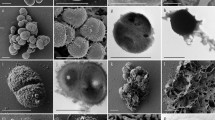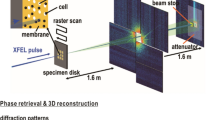Abstract
Isolated chlorosomes of several species of filamentous anoxygenic phototrophic bacteria (FAPB) and green sulfur bacteria (GSB) were examined by atomic force microscopy (AFM) to characterize their topography and biometry. Chlorosomes of Chloroflexus aurantiacus, Chloronema sp., and Chlorobium (Chl.) tepidum exhibited a smooth surface, whereas those of Chl. phaeobacteroides and Chl. vibrioforme showed a rough one. The potential artifactual nature of the two types of surfaces, which may have arisen because of sample manipulation or AFM processing, was ruled out when AFM images and transmission electron micrographs were compared. The difference in surface texture might be associated with the specific lipid and polypeptide composition of the chlorosomal envelope. The study of three-dimensional AFM images also provides information about the size and shape of individual chlorosomes. Chlorosomal volumes ranged from ca. 35 000 nm3 to 247 000 nm3 for Chl. vibrioforme and Chl. phaeobacteroides, respectively. The mean height was about 25 nm for all the species studied, except Chl. vibrioforme, which showed a height of only 14 nm, suggesting that GSB have 1–2 layers of bacteriochlorophyll (BChl) rods and GFB have ∼4. Moreover, the average number of BChl molecules per chlorosome was estimated according to models of BChl rod organisation. These calculations yielded upper limits ranging from 34 000 BChl molecules in Chl. vibrioforme to 240 000 in Chl. phaeobacteroides, values that greatly surpass those conventionally accepted.
Similar content being viewed by others
References
Arellano JB, Pšenčík J, Borrego CM, Ma YZ, Guyoneaud R, Garcia-Gil LJ and Gillbro T (2000) Effect of carotenoid biosynthesis inhibition on the chlorosome organization in Chlorobium phaeobacteroides strain CL1401. Photochem Photobiol 71: 715–723
Arellano JB, Borrego CM, Martinez-Planells A and Garcia-Gil LJ (2001) Effect of carotenoid deficiency on cells and chlorosomes of Chlorobium phaeobacteroides. Arch Microbiol 175: 226–233
Binnig G, Quate CF and Gerber Ch (1986) Atomic force microscope. Phys Rev Lett 56: 930–933
Blankenship RE, Olson JM and Miller M (1995) Antenna complexes from green photosynthetic bacteria. In: Blankenship RE, Madigan MT and Bauer CE (eds) Anoxygenic Photosynthetic Bacteria, pp 399–435. Kluwer Academic Publishers, Dordrecht, The Netherlands
Boulbitch A (2000) Deformation of the envelope of a sphaerical Gram-negative bacterium during the atomic force microscopic measurements. J Electron Microscopy 49: 459–462
Cahill AD and Stolz JF (1995) Polyclonal antibodies to chlorosome proteins as probes for green sulfur bacteria. Appl Environ Microbiol 61: 784–787
Chung S and Bryant DA (1996) Characterization of the csmD and csmE genes from Chlorobium tepidum. The CsmA, CsmC, CsmD, and CsmE proteins are components of the chlorosome envelope. Photosynth Res 50: 41–59
Czajkowsky DM, Iwamoto H and Zhao Z (2000) Atomic force microscopy in structural biology: from the subcellular to the submolecular. J Electron Microscopy 49: 395–406
Engel A and Muller DJ (2000) Observing single biomolecules at work with the atomic force microscope. Nat Struct Biol 7(9): 715–718
Feick RG, Fitzpatrick M and Fuller RC (1982) Isolation and characterization of cytoplasmic membranes and chlorosomes from the green bacterium Chloroflexus aurantiacus. J Bacteriol 150: 905–915
Foidl M, Golecki JR and Oelze J (1997) Phototrophic growth and chlorosome formation in Chloroflexus aurantiacus under conditions of carotenoid deficiency. Photosynth Res 54: 219–226
Fotiadis D, Müller DJ, Tsiotis B, Hasler L, Tittmann P, Mini T, Jenö P, Gross H and Engel A (1998) Surface analysis of the Photosystem I complex by electron and atomic force microscopy. J Mol Biol 283: 83–94
Gerola P and Olson JM(1986) A new bacteriochlorophyll a-protein complex associated with chlorosomes of green sulfur bacteria. Biochim Biophys Acta 848: 69–76
Golecki JR and Oelze J (1987) Quantitative relationships between bacteriochlorophyll content, cytoplasmic membrane structure and chlorosome size in Chloroflexus aurantiacus. Arch Microbiol 148: 236–241
Hanada S, Hiraishi A, Shimada K and Matsuura K (1995) Isolation of Chloroflexus aurantiacus and related thermophilic phototrophic bacteria from Japanese hot spring using an improved isolation procedure. J Gen Appl Microbiol 41: 119–130
Hansma HG, Kim KJ and Laney DE (1997) Properties of biomolecules measured from atomic force microscope images: A review. J Struct Biol 119: 99–108
Hoffmann E, Wrench PM, Sharples FP, Hiller RG, Welte W and Diederichs K (1996) Structural basis of light harvesting by carotenoids: peridin-chlorophyll-protein from Amphidinium carterae. Science 272: 1788–1791
Holo H, Broch-Due M and Ormerod JG (1985) Glycolipids and the structure of chlorosomes in green bacteria. Arch Microbiol 143: 94–99
Holzwarth AR, Griebenow K and Schaffner K (1990) A photosynthetic antenna system which contains a protein-free chromophore aggregate. Z Naturforsch 45: 203–296
Kühlbrandt W, Wang DN and Fujiyoshi Y (1994) Atomic model of plant light-harvesting complex by electron crystallography. Nature 367: 614–21
McDermott G, Prince SM, Freer AA, Hawthornthwaite-Lawless AM, Papiz MZ, Cogdell RJ and Isaacs NW (1995) Crystal structure of an integral membrane light-harvesting complex from photosynthetic bacteria. Nature 374: 517–521
Mizoguchi TK, Matsuura K, Shimada K and Koyama Y (1996) The structure of the aggregate form of bacteriochlorophyll c showing the Qy absorption above 740 nm: A 1H-NMR study. Chem Phys Lett 260: 153–158
Möller C, Allen M, Elings V, Engel A and Müller DJ (1999) Tapping-mode atomic force microscopy produces faithful high-resolution images of protein surfaces. Biophys J 77: 1150–1158
Oelze J and Golecki JR (1995) Membranes and chlorosomes of Green Bacteria: Structure, composition and Development. In: Blankenship BE, Madigan MT and Bauer CE (eds) Anoxygenic Photosynthetic Bacteria, pp 259–278. Kluwer Academic Publishers, Dordrecht, The Netherlands
Olson JM (1998) Chlorophyll organization and function in green photosynthetic bacteria. Photochem Photobiol 67: 61–75
Prokhorenko VI, Steensgaard DB and Holzwarth AR (2000) Exciton dynamics in the chlorosomal antennae of the green bacteria Chloroflexus aurantiacus and Chlorobium tepidum. Biophys J 79: 2105–2120
Seelert H, Poetsch A, Dencher NA, Engel A, Stahlberg H and Müller DJ (2000) Structural biology: proton-powered turbine of a plant motor. Nature 405: 418–419
Scheuring S, Tittmann P, Stahlberg H, Ringler P, Borgnia M, Agre P, Gross H and Engel A (2000) The aquaporin sideness revisited. J Mol Biol 299: 1271–1278
Schmidt K (1980) A comparative study on the composition of chlorosomes (Chlorobium vesicles) and cytoplasmic membranes from Chloroflexus aurantiacus strain Ok-70-fl and Chlorobiumm limicola f. thiosulfatophilum strain 6230. Arch Microbiol 124: 21–31
Schmidt K, Maarzahl M and Mayer F (1980) Development and pigmentation of chlorosomes in Chloroflexus aurantiacus strain Ok-70-fl. Arch Microbiol 127: 87–97
Schneider SW, Egan ME, Jena BP, Guggino WB, Oberleithner H and Geibel JP (1999) Continuous detection of extracellular ATP on living cells by atomic force microscopy. Proc Natl Acad Sci USA 96: 12180–12185
Staehelin LA, Golecki JR, Fuller RC and Drews g (1978) Visualization of the supramolecular architecture of chlorosomes (Chlorobium type vesicles) in freeze-fractured cells of Chloroflexus aurantiacus. Arch Microbiol 119: 269–277
Staehelin LA, Golecki JR and Drews G (1980) Supramolecular organization of chlorosomes (Chlorobium vesicles) and on their membrane attachment sites in Chlorobium limicola. Biochim Biophys Acta 589: 30–45
Steensgaard DB, Matsuura K, Cox RP and Miller M (1997) Changes in bacteriochlorophyll c organization during acid treatment of chlorosomes from Chlorobium tepidum. Photochem Photobiol 65: 129–134
Steensgaard DB, Wackerbarth H, Hildebrandt P and Holzwarth AR (2000) Diastereoselective control of bacteriochlorophyll e aggregation. 31-S-BChl e is essential for the formation of chlorosome-like aggregates. J Phys Chem B 104: 10379–10386
Stolz JF, Fuller RC and Redlinger TE (1990) Pigment-protein diversity in chlorosomes of green phototrophic bacteria. Arch Microbiol 154: 422–427
Trüper HG and Pfennig N (1992) The family Chlorobiaceae. In: Ballows A, Trüper HG, Dworkin M, Harder W and Schleifer KH (eds) The Prokaryotes, A Handbook on the Biology of Bacteria: Ecophysiology, Isolation, Identification, Applications, second edition, pp 3583–3592. Springer-Verlag, Berlin
Viani MB, Pietrasana LI, Thompson JB, Chand A, Gebeshuber IC, Kindt JH, Richter M and Hansma PK (2000) Probing proteinproton interactions in real time. Nature Struct Biol 7: 644–647
Walz T, Tittmann P, Fuchs KH, Müller DJ, Smith BL, Agre P, Gross H and Engel A (1996) Surface topographies at subnanometerresolution reveal asymmetry and sidedness of aquaporin-1. J Mol Biol 264: 907–918
Wang Z, Marx G, Umetsu M, Kobayashi M, Mimuro M and Nozawa T (1995) Morphology and spectroscopy of chlorosomes from Chlorobium tepidum by alcohol treatments. Biochim Biophys Acta 1232: 187–196
Zhong Q, Inniss D, Kjoller K and Elings VB (1993) Fractured polymer/silica fiber surface studied by tapping mode atomic force microscopy. Surface Sci Lett 290: 888–692
Zhu Y, Ramakrishna BL, van Noort PI and Blankenship RE (1995) Microscopic and spectroscopic studies of untreated and hexanoltreated chlorosomes from Chloroflexus aurantiacus. Biochim Biophys Acta 1232: 197–207
Author information
Authors and Affiliations
Corresponding author
Rights and permissions
About this article
Cite this article
Martinez-Planells, A., Arellano, J.B., Borrego, C.M. et al. Determination of the topography and biometry of chlorosomes by atomic force microscopy. Photosynthesis Research 71, 83–90 (2002). https://doi.org/10.1023/A:1014955614757
Issue Date:
DOI: https://doi.org/10.1023/A:1014955614757




